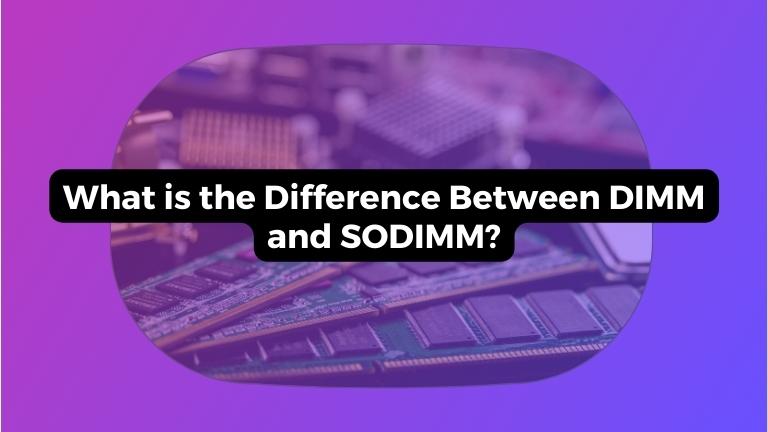RAM, or Random Access Memory, is an essential part of any computer system as it provides a temporary storage space for data that the CPU, or Central Processing Unit, needs to access quickly.
When you open a program or file, it gets loaded into RAM, allowing the CPU to access it much faster than if it had to read it from a hard drive. When purchasing RAM, there are several factors to consider, including speed, capacity, and compatibility.
One crucial aspect to understand is the difference between DIMM and SODIMM memory modules. When you are buying RAM to upgrade your computer or building a new system from scratch, you may have come across the terms DIMM and SODIMM.
But what exactly do these acronyms mean, and what’s the difference between them? In this article, we’ll take a closer look at these two types of memory modules and explore their similarities and differences.
What is RAM?
RAM (Random Access Memory) is a vital component of a computer system that allows the CPU (Central Processing Unit) to access data quickly. This type of computer memory is volatile, which means that it requires power to maintain its contents.
RAM is available in various shapes and sizes, but all types of RAM serve the same purpose: to provide temporary storage space for data that the CPU needs to access quickly.
Having more RAM allows you to keep multiple programs and files open simultaneously without slowing down your computer.
What is DIMM?
DIMM or Dual In-Line Memory Module is a type of RAM module that is commonly used in desktop computers. DIMMs have two notches on the connector that helps ensure they are installed in the correct orientation.
DIMMs are available in different speeds, capacities, and types, such as DDR3, DDR4, and DDR5. The speed of a DIMM is measured in MHz (megahertz), and the capacity is measured in GB (gigabytes).
When buying a DIMM, make sure it is compatible with your motherboard and meets your needs in terms of speed and capacity.
What is SODIMM?
SODIMM is short for Small Outline Dual In-Line Memory Module. It is a type of RAM module that is frequently used in laptops and other small form factor devices.
SODIMMs only have one notch on the connector, making it easier to install in the correct orientation.
Like DIMMs, SODIMMs come in various speeds, capacities, and types, including DDR3, DDR4, and DDR5. However, they are smaller than DIMMs and have fewer pins, which means they typically have lower capacity and slower speed compared to DIMMs.
Nevertheless, SODIMMs are essential for laptops and other small form-factor devices where space is limited.
Similarities between DIMM and SODIMM
Despite their differences, there are some similarities between DIMM and SODIMM. Both are types of RAM modules that provide temporary storage space for data that the CPU needs to access quickly.
They also use the same types of memory technology, such as DDR3, DDR4, and DDR5. Additionally, both DIMM and SODIMM have a similar installation process, where they need to be inserted into the appropriate slot on the motherboard.
It’s essential to make sure that they’re compatible with the motherboard and that they meet your needs in terms of speed and capacity.
Differences between DIMM and SODIMM
Now let’s take a closer look at the differences between DIMM and SODIMM:
Form Factor
Another difference between DIMMs and SODIMMs is that DIMMs are commonly used in desktop computers, while SODIMMs are commonly used in laptops and other small form factor devices.
This is because SODIMMs are designed to be smaller and more compact, which makes them ideal for use in devices with limited space for hardware components.
Additionally, SODIMMs typically have lower power consumption compared to DIMMs, which can be important in devices that have limited battery life, such as laptops and tablets.
Compatibility
The different form factors of DIMMs and SODIMMs make them incompatible with each other’s systems. It’s important to check the specifications of your computer’s motherboard to ensure that you’re buying the correct type of RAM for your system. Installing incompatible RAM can result in system instability and other issues.
Capacity and Speed
As previously mentioned, DIMMs generally have a larger capacity and faster speed compared to SODIMMs. DIMMs can have a maximum capacity of up to 128GB and a speed of up to 6400MHz, while SODIMMs have a maximum capacity of up to 32GB and a speed of up to 3200MHz.
Price
It’s true that due to their larger size, higher capacity, and faster speed, DIMMs are generally more expensive than SODIMMs.
However, the price difference can vary depending on the specific type and brand of RAM you’re looking at, and in some cases, the price difference between DIMMs and SODIMMs may not be significant.
Ultimately, the cost will depend on your specific needs and budget.
Which one should you choose?
To sum up, the choice between DIMM and SODIMM depends on the type of computer you have or are building. DIMMs are used in desktop computers, while SODIMMs are used in laptops and small form factor devices.
When choosing between different types of RAM, consider your needs in terms of capacity and speed. Heavy users may want higher capacity and faster speed, while casual users may find lower capacity and slower speed sufficient.
Regardless of your needs, make sure to choose a RAM module that’s compatible with your motherboard and meets your system requirements.
How to install DIMM and SODIMM
Installing DIMMs and SODIMMs is a relatively simple process. Here’s a step-by-step guide:
- Make sure that your computer is turned off and unplugged.
- Open the case of your desktop computer or the back cover of your laptop.
- Locate the RAM slots. They’re usually located near the CPU or the battery.
- If you’re replacing an existing RAM module, gently push down on the latches on either side of the module to release it.
- If you’re installing a new module, make sure that you insert it into the slot at a 45-degree angle, then press down until the latches click into place.
- Close the case or back cover, then turn on your computer.
Troubleshooting tips
If you’re having trouble with your RAM, here are some troubleshooting tips:
- Make sure that your RAM is properly installed and seated in the slots.
- Check your motherboard’s manual to make sure that your RAM is compatible.
- Run a memory diagnostic tool to check for any errors or issues.
- Try removing and reinserting your RAM to see if that fixes the problem.
- If all else fails, consider replacing your RAM with a new module.
Conclusion
In summary, DIMM and SODIMM are two different types of RAM modules used in different types of computers. DIMMs have a higher capacity and faster speed, are larger, and are used in desktop computers, while SODIMMs have a lower capacity and slower speed, are smaller, and are used in laptops and small form factor devices.
When choosing between DIMM and SODIMM, you should consider compatibility with your computer and your needs in terms of capacity and speed.
Installing DIMM and SODIMM is easy, but if you have issues with your RAM, there are troubleshooting tips you can follow to diagnose and fix the problem. It’s essential to research the specific type and brand of RAM you choose as it can affect performance and price.
Understanding the differences between DIMM and SODIMM can help you make an informed decision when it comes to upgrading or building your computer.









